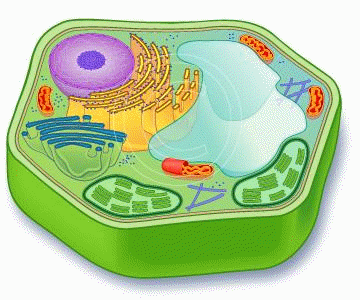 Plant cells have several structures not found in other eukaryotes.
Chloroplasts allow plants to capture the energy of the Sun in energy–rich molecules; cell
walls allow plants to have rigid structures as varied as wood trunks and supple leaves; and vacuoles allow plant cells
to change size.
Plant cells have several structures not found in other eukaryotes.
Chloroplasts allow plants to capture the energy of the Sun in energy–rich molecules; cell
walls allow plants to have rigid structures as varied as wood trunks and supple leaves; and vacuoles allow plant cells
to change size.
Plant cells are eukaryotic cells, or cells with a membrane–bound nucleus.
Unlike prokaryotic cells, the DNA in a plant cell is housed within the nucleus. In addition to having a nucleus, plant cells also contain other membrane–bound organelles, or tiny cellular structures, that carry out specific functions necessary for normal cellular operation.
Plant cells have several structures not found in other eukaryotes. In particular, organelles called chloroplasts allow plants to capture the energy of the Sun in energy–rich molecules; cell walls allow plants to have rigid structures as varied as wood trunks and supple leaves; and vacuoles allow plant cells to change size.
 Plants are the most familiar type of autotrophs
Plants contain chloroplasts which contain chlorophyll, a green–colored pigment that absorbs sunlight,
and allows the plant to make its own food in the process known as photosynthesis.
Plants are the most familiar type of autotrophs
Plants contain chloroplasts which contain chlorophyll, a green–colored pigment that absorbs sunlight,
and allows the plant to make its own food in the process known as photosynthesis.
Plant cells are eukaryotic cells that differ in several key aspects from the cells of other eukaryotic organisms. Their distinctive features include:
- A cell wall composed of cellulose and hemicellulose, pectin and in many cases lignin, is secreted by the protoplast on the outside of the cell membrane. This contrasts with the cell walls of fungi (which are made of chitin), and of bacteria, which are made of peptidoglycan.
- Plastids/chloroplasts contains chlorophyll, a green–colored pigment that absorbs sunlight, and allows the plant to make its own food in the process known as photosynthesis. Other types of plastids are the amyloplasts, specialized for starch storage, elaioplasts specialized for fat storage, and chromoplasts specialized for synthesis and storage of pigments. As in mitochondria, which have a genome encoding 37 genes, plastids have their own genomes of about 100–120 unique genes.
- Cell division by construction of a phragmoplast as a template for building a cell plate late in cytokinesis is characteristic of land plants and a few groups of algae, notably the Charophytes and the Order Trentepohliales.
- A large central vacuole, a water–filled volume enclosed by a membrane known as the tonoplast that maintains the cell's turgor, controls movement of molecules between the cytosol and sap, stores useful material and digests waste proteins and organelles.
- Specialized cell–to–cell communication pathways known as plasmodesmata, pores in the primary cell wall through which the plasmalemma and endoplasmic reticulum of adjacent cells are continuous.
Plants are the most familiar type of autotrophs. An autotroph is an organism that can produce its own food using light, water, carbon dioxide, or other chemicals. Most autotrophs use a process called photosynthesis to make their food. In photosynthesis, autotrophs use energy from the sun to convert water from the soil and carbon dioxide from the air into a nutrient called glucose. Glucose is a type of sugar. The glucose gives plants energy. Plants also use glucose to make cellulose, a substance they use to grow and build cell walls.